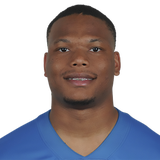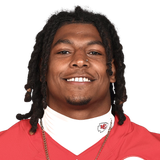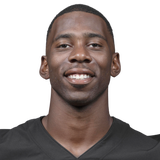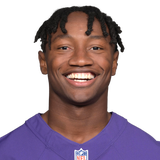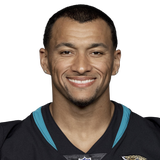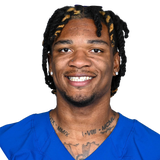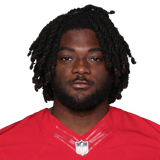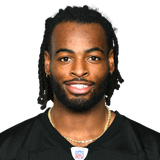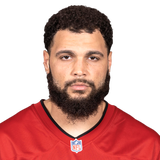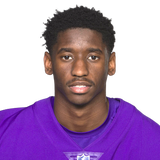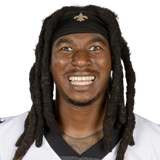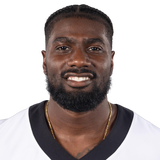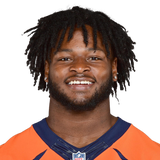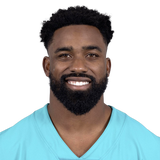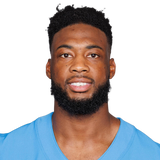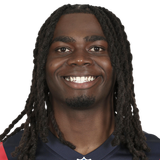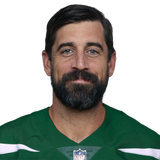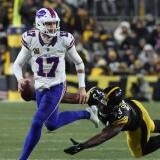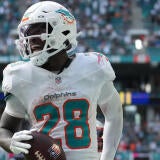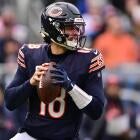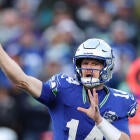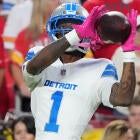NFL Fantasy Football Week 1 Lineup Decisions: Starts, Sits, Sleepers, Busts to know for every game
Dig into the players who might be tough start/sit calls in your lineup and who could be the breakout stars everyone wants in Week 2
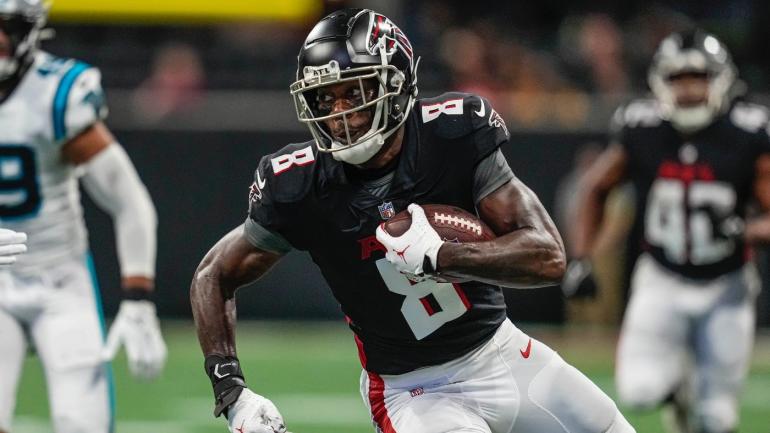
Fantasy Football is all about the matchups. Even though you drafted your team with certain hopes and intentions, your weekly lineup decisions shouldn't be determined by the order you picked your players in. You need to check who your players play and make sure you've got the right guys in -- and the wrong guys out.
It's too early to be absolutely sure on which matchups will be easy and which ones will be tough, but we can take some educated guesses based on healthy personnel, defensive schemes, track records and key details of offenses. The things we know can help us minimize the impact of the things we don't know. This should lead to better decisions being made.
We'll go through every game and highlight the players who aren't obvious starts and sits (because you don't need to be told to start Justin Jefferson). You should feel more comfortable starting or sitting players based on the information given, and feeling comfortable with your Fantasy lineup before the games start is the best feeling in the world.
You'll be able to find my full notes on every player from every game that would qualify as a tough start/sit over at SportsLine shortly. For now, you can find Heath Cummings full set of Week 1 Fantasy football projections for every position available on SportsLine. Find out which of my favorite plays are projected to score higher than consensus rankings and which don't live up to their draft hype, at least in Week 1. Projected stats for all starting positions are available, so be sure to check out the full set of projections at SportsLine.
All lines from Caesars Sportsbook.
| ||||||||||||||||||
CHIEFS: Won't have top D-tackle Chris Jones, who is continuing his holdout. Without him, Kansas City's top pass rushers are George Karlaftis and Mike Danna, neither of whom had a pass rush win-rate north of 10.5% in 2022 despite a combined 772 pass rush snaps.
GOFF: Has always struggled when under pressure but was outstanding last year when not pressured -- 73.4% completion rate, 8.3 yards per attempt with a shorter Average Depth of Target (ADOT) of 6.7 yards versus when he was pressured. His offensive line remains one of the better front fives in the league.
LIONS: Added two explosive rookies: running back Jahmyr Gibbs (a must-start) and tight end Sam LaPorta (read below). Gibbs was outstanding in joint practices against the Giants earlier this summer and should draw exceptional matchups against the Chiefs' linebackers and safeties and may even dictate zone coverage for the majority of the game.
FOR WHAT IT'S WORTH: Goff finished 2022 with 21-plus Fantasy points in 5 of his final 7 games including four with 25 or more.
Goff has low-end QB1 appeal given the likelihood of Detroit being forced to score a bunch to keep up with the Chiefs offense and his new weapons in an offense he's already had success in. Having top-notch protection against a suspect pass rush is a huge factor. I'd start him over Anthony Richardson, Kirk Cousins and Aaron Rodgers.
| ||||||||||||||||||
CHIEFS: Won't have top D-tackle Chris Jones, who is continuing his holdout. Big-bodied defenders Derrick Nnadi and Tershawn Wharton graded out poorly versus the run according to Pro Football Focus, meaning more of an emphasis on stopping Montgomery will fall on linebackers Willie Gay, Nick Bolton and Drue Tranquil. Of the three, only Bolton graded out well versus the run.
CHIEFS: Saw the fourth-fewest RB rushes per game last year (18.9), likely a by-product of holding so many leads. But of the teams that saw under 20.0 RB rushes per game, the Chiefs were the only one to allow over 4.0 yards per carry (4.3) with all six touchdowns allowed coming from 5 yards or closer.
LIONS: Ranked fifth in RB rush attempts per game (25.1) in 2022 and theoretically upgraded at the position with Montgomery, who will replace ineffective-except-at-the-goal-line power back Jamaal Williams. Lions RBs totaled at least 20 carries in all but two games last season. They also averaged 2.3 rushes per game from five yards or closer to the goal line, a fertile space reserved, presumably, for their big back.
Gibbs is an exciting addition to the Lions offense, and he's a better PPR starter than Montgomery for sure, but Montgomery's chances for 15 touches and a touchdown keep him above the RB2 fold. I'd start him over Najee Harris, Isiah Pacheco, any Eagles RB, any Jets RB and Jamaal Williams.
| ||||||||||||||||||
PACHECO: Set for his first taste of live action after missing the majority of training camp and the preseason recovering from a torn labrum in his shoulder.
LAST YEAR: Despite leading the Chiefs in rushing, Pacheco never played 50% of the snaps in any regular-season game. He had one playoff game with 57% of the snaps (versus Cincinnati); he played 47% of the snaps in the Super Bowl.
LAST 12 GAMES: Notched at least 80 total yards nine times, including 2 of 3 playoff games.
THIS YEAR: There's no telling how much he'll play in his first matchup but he should play a decent amount -- he was not listed on the team's injury report.
LIONS: Rated poorly in yards per carry allowed over the season last year (4.7), so they drafted middle linebacker Jack Campbell to help support the run. He won't play every down but he'll mix in. The defensive line is the larger concern as multiple unknown players who had suspect PFF grades will see playing time.
CHIEFS: Called RB rushes 19.7 times per game in 2022, tied for seventh-fewest. Not having Travis Kelce available could pump that number up.
Pacheco is risky not only in terms of his production but in terms of his workload. It's better to take a wait-and-see approach with him if you can; if he lights up the Lions at least you'll know what to do with him in Weeks 2 and 3 against the Jaguars and Bears.
| ||||||||||||||||||
PITTS: Played a total of eight preseason snaps, limited in both his time with the starters and in practice for much of August as he rehabs from offseason knee surgery. Appeared to be lumbering both in a joint practice against the Dolphins and in his eight preseason snaps against the Bengals.
PANTHERS: New defensive coordinator Ejiro Evero called zone coverage for the Broncos over 77% of the time last season, suggesting that he will continue to call zone coverage frequently with Carolina.
PITTS: Has struggled in his career against the Panthers, scoring over 12 PPR points once in four games. That big game included a touchdown and came without terrific linebacker/safety cover man Jeremy Chinn on the field. Chinn should play and figures to cover Pitts a healthy amount.
PITTS: Struggled versus zone coverage last season, catching just 44/7% of his targets against the scheme, albeit for 14.6 yards per catch. He saw way more targets against zone (47) than man (9).
Pitts was drafted to be a starter, and should be started, but don't expect a huge game. His health might be the most prohibitive factor, if not the Falcons finding themselves successful in the run game. Still a top-10 tight end this week, but perhaps not a top-5.
| ||||||||||||||||||
FLOWERS: Shined in one preseason game (14 snaps) but was also a highlight reel in training camp, and was amazing last year at Boston College.
RAVENS: No one's sure which WR will line up where, and it's likely all three receivers will mix and match, but Flowers could edge out Odell Beckham and Rashod Bateman for those slot snaps. Flowers didn't do much of it this preseason (21.4% of his snaps in the slot), nor did he specialize in it at Boston College (35% in 2022), but Odell Beckham and Rashod Bateman lined up in the slot less than 20% of the time in their past four and two seasons, respectively.
TEXANS: Demeco Ryans' 49ers defense played the fourth-highest zone snaps in 2022. Ryans figures to follow suit with the Texans for much of this season, and most certainly will play heavy zone coverage against Baltimore to not only keep the receivers from beating them deep but also to keep eyes on Lamar Jackson for those plays he takes off and runs on.
TEXANS: Have some interesting cornerbacks -- second-year bounce-back talent Derek Stingley and veteran Steven Nelson figure to line up outside the most with Tavierre Thomas in the slot. Thomas was a second-half contributor for the Texans in 2022 and out-played veteran Desmond King for the nickelback job. These players may not be huge factors individually since they'll play a lot of zone coverage, but Stingley's speed and strength from the left cornerback spot could be the toughest for Beckham and Bateman -- two guys coming back from injury -- to deal with.
Flowers strikes me as the kind of player who could catch two passes but total 70 yards and a touchdown on them. But so too might Beckham or Bateman, which makes all three receivers risky from week to week. At least in the case of Flowers he'll have relative anonymity on his side, plus he might draw the easier matchups as long as he stays away from Stingley (IF Stingley stays stationary at left cornerback). Flowers is a risk as a flex, but one with tremendous upside without the age or injury concerns other Ravens wideouts have.
| ||||||||||||||||||
NJOKU: Quite clearly a significant part of the Browns offense last year, Njoku is expected to reprise his role as a short-area target who will be leaned on given his size and athleticism.
LAST SEASON: In one game, Njoku drew nine targets and posted a 7-59-1 stat line thanks to a slew of short-range targets from Deshaun Watson along with a very clever red-zone play-call that got the entire Bengals defense off-balance.
Deshaun Watson scores his first TD for the Cleveland @Browns !!
— #ClemsonNFL (@ClemsonPros) December 11, 2022
pic.twitter.com/hQKS0hEuw0
HISTORY: Njoku has scored in three of his past four games against the Bengals.
BENGALS: Expected to play a lot of zone coverage this week. Were fine covering tight ends last year (about league average in Fantasy points allowed) and did little this offseason to improve how they cover them. Safeties Jessie Bates and Vonn Bell both left; Nick Scott and Dax Hill are expected to replace them with Hill more likely to see coverage of Njoku along with linebackers Logan Wilson and Germaine Pratt.
NJOKU: Was more effective against zone coverage (12.0 yards per catch) than man coverage (9.6).
The matchup isn't any harder this year for "The Chief" and the Bengals offense figures to be a little more pass-friendly than it has ever been. Njoku has a shot at finishing as a top-five TE this week. I'd start him over Pat Freiermuth, Evan Engram and Kyle Pitts.
| ||||||||||||||||||
ROBINSON: Began the preseason as the Commanders' first RB up, though the preseason snap share has Gibson with a 4% advantage. When the Commanders moved inside the red zone it was an even 50-50 split, though Gibson played two third downs while Robinson played none.
ROLES: Projects as more of a physical back who can catch if a pass play is dialed up, while Gibson is more of an air back who can pound it between the tackles if asked. Last year Gibson played just 23 more snaps than Robinson in the 11 games they were both active for, but Robinson had a slight edge on snaps inside the three-yard line while Gibson had a significant edge (51 more snaps) on third downs.
PRESEASON: It's a tiny sample size, but Robinson looked like the better rusher this summer, not only seeing a higher opportunity share (46.4% to 36.7%) but having better efficiency overall (4.6 yards per carry over eight rushes compared to 3.7 over six rushes for Gibson).
CARDINALS: This is really where you should get excited about starting Robinson: Arizona's defensive line struggled to grade well with Pro Football Focus in the past, their linebackers are at best decent and their safeties are the strength, though they already traded away one quality defender in Isaiah Simmons. Even against Washington's offense, the Cardinals figure to have their hands full.
If you start Robinson, you're hoping he finds the end zone and leads the Commanders in carries in what appears to be an easy matchup against an already-depleted Cardinals defense. It only helps that Arizona's offense is almost as depleted to start the year, likely giving Washington a nice edge in time of possession. While Gibson is a decent PPR flex, I like Robinson's scoring upside to carry him to a better Week 1 than David Montgomery and Najee Harris.
| ||||||||||||||||||
LAST YEAR: Engram got plenty of targets (14 in two games) but was used mostly on short throws including designed screens in their first matchup. Lawrence did miss Engram on a potential touchdown when the tight end broke free from coverage early in the first matchup but there weren't a lot of chances for a big score otherwise, just a lot of volume.
JAGUARS: New addition Calvin Ridley figures to draw the most targets, which means Engram will be a week-to-week, matchup-dependent option. Luckily, he has the matchup this week.
COLTS: Have questions all over the defense but certainly when it comes to covering athletic tight ends. Linebackers Zaire Franklin and Shaquille Leonard (if he plays) have allowed high catch rates over their careers, and new safeties Rodney Thomas and especially Julian Blackmon have as well.
LAST YEAR: Indy used a lot of cornerbacks on Engram, which wound up working against them as Engram drew quality coverage away from Christian Kirk, who scored three times in two games. Indy has refreshed its outside cornerbacks this offseason; it may induce some matchups for the Jaguars to go after with all their pass-catchers, not just Engram.
If you start Engram, you're banking on the Jaguars throwing a good amount even in a game where they could blow out their opponent. That could just be the M.O. of Jacksonville's offense this year. Use him while you can because matchups will come down the pike where Engram could be a non-factor. I'd start Engram this week over Pat Freiermuth, Juwan Johnson and any rookie TE.
| ||||||||||||||||||
LAST YEAR: Engram got plenty of targets (14 in two games) but was used mostly on short throws including designed screens in their first matchup. Lawrence did miss Engram on a potential touchdown when the tight end broke free from coverage early in the first matchup but there weren't a lot of chances for a big score otherwise, just a lot of volume.
JAGUARS: New addition Calvin Ridley figures to draw the most targets, which means Engram will be a week-to-week, matchup-dependent option. Luckily, he has the matchup this week.
COLTS: Have questions all over the defense but certainly when it comes to covering athletic tight ends. Linebackers Zaire Franklin and Shaquille Leonard (if he plays) have allowed high catch rates over their careers, and new safeties Rodney Thomas and especially Julian Blackmon have as well.
LAST YEAR: Indy used a lot of cornerbacks on Engram, which wound up working against them as Engram drew quality coverage away from Christian Kirk, who scored three times in two games. Indy has refreshed its outside cornerbacks this offseason; it may induce some matchups for the Jaguars to go after with all their pass-catchers, not just Engram.
If you start Engram, you're banking on the Jaguars throwing a good amount even in a game where they could blow out their opponent. That could just be the M.O. of Jacksonville's offense this year. Use him while you can because matchups will come down the pike where Engram could be a non-factor. I'd start Engram this week over Pat Freiermuth, Juwan Johnson and any rookie TE.
| ||||||||||||||||||
AIYUK: Remains one of the three most explosive playmakers in the 49ers offense.
49ERS: If they struggle to run the ball against the Steelers' front, figure Brock Purdy will keep the secondary guessing with a lot of short throws. There might be concerns about Purdy's arm strength beyond what we saw last season.
STEELERS: Among the league's most man-heavy coverage defenses last year, but that could be a dangerous formula this week given Aiyuk, Deebo Samuel and Christian McCaffrey in the 49ers offense. It should also be noted that the Steelers went 6-2 last season when they played zone coverage 65% of the time or more in a game (and 3-6 when they didn't). Pittsburgh finished 2022 playing their heaviest zone coverage and went 3-0.
AIYUK: Didn't see as many targets on a per-route basis last year versus zone coverage (20.2% versus 29.3% against man) but did have a higher catch rate (72.4% versus 61.1%) and fielded a higher ADOT (10.54 versus 9.08) against zone. Obviously his explosiveness is better against man coverage because he can beat single coverage.
LAST YEAR: Seven of Aiyuk's last 12 games resulted in at least 13 PPR points, and all but one of those 12 games resulted in at least 9.6 PPR points.
Aiyuk will line up across from veteran corners like Levi Wallace and Patrick Peterson, both of whom allowed a sub-60% completion rate last year. That's a little scary, but Aiyuk's upside is matchup-proof given his explosiveness. If the Steelers run defense was worse I'd step back from Aiyuk, but it's not, so Aiyuk has some potential to be at least a flex. I'd start him over Chris Godwin, Diontae Johnson and Christian Kirk.
| ||||||||||||||||||
HARRIS: Ended 2022 with at least 13 PPR points in each of his final five games, but only once in that span did he get 16-plus PPR. In those final five, touchdowns accounted for 30.8% of his total PPR scoring.
TOUCHDOWNS: Are what you'll need for Harris if he remains as inefficient as he was in the back-half of 2022.
49ERS: Allowed seven touchdowns to running backs last season, tied for fifth-fewest in the NFL, and only four of the seven came from three yards or closer.
49ERS: Added massive D-tackle Javon Hargrave to their defensive line rotation to better help against the run. Oren Burks may not be available, but Fred Warner and Dre Greenlaw have been strong linebackers against the run for several years with safety Talanoa Hufanga playing behind them. It's a tough unit.
WARREN: Though beat reports suggest Harris is still the Steelers' top running back for now, there's been enough evidence through training camp and in preseason games to suggest that Jaylen Warren could pick up work not only in obvious passing situations, but in some running situations as well. Harris held a smaller-than-expected lead in preseason snaps with the starting offense in August (57% to 43%). We could see a similar snap share in Week 1, particularly if the 49ers keep Harris bottled up.
There have been just five times in Harris' 34 regular-season outings where he's topped 15 PPR points without scoring a touchdown, and three of those five were barely over 15 PPR points (no more than 17.0). So if you don't think he's scoring, don't expect a monster game. RBs with more upside in PPR include Brian Robinson, James Conner and James Cook.
| ||||||||||||||||||
EVANS: Remains locked into every-down work for the Bucs, but this year he's expected to move around the formation more in an effort to find favorable matchups. Evans hasn't played more than 24% of his snaps in the slot over his past four seasons.
BAKER MAYFIELD: Has actually looked not awful this summer according to multiple accounts. That was certainly the case in preseason games when he threw almost exclusively short passes, completing all but one of his 15 tries. He also tossed two touchdowns over three red-zone attempts.
VIKINGS: Significant questions in the defensive secondary. Byron Murphy should be a staple who plays in the slot against three-wide formations, but otherwise they'll count on man-coverage specialist rookie Mekhi Blackmon and, presumably, Akayleb Evans as their other corners. There's no question they'll get tested.
VIKINGS: Have a great pass rush duo in Danielle Hunter and Marcus Davenport, but the rest of the front seven isn't particularly worrisome. Mayfield could get blitzed a bunch, but if he's getting rid of the ball quickly then he'll overcome it more often than not.
A savvy veteran like Evans should find himself in position for a good amount of targets in a favorable matchup against an incomplete Vikings defense that could end up taking a lot of chances with their coverage. He barely makes the cut as a WR2 and, for this week, is a safer start in full PPR over Brandon Aiyuk, Courtland Sutton, George Pickens and Marquise Brown.
| ||||||||||||||||||
ADDISON: Expected to work as the No. 2 receiver for the Vikings, albeit by a narrow margin over K.J. Osborn. Both did not play in the preseason, suggesting they're considered valuable offensive players. Neither should see a lot of heavy coverage given they play alongside Justin Jefferson.
BUCCANEERS: Were a zone-heavy squad last year (73.2% of their defensive snaps) and figure to be again under coach and playcaller Todd Bowles. Cornerbacks Jamel Dean and Carlton Davis are quality starters on the outside but questions persist about the middle of the field, notably at the intermediate level.
ADDISON: Had a high catch rate at USC last year regardless of coverage but managed better efficiency against zone coverage (16.0 yards per catch and 7.4 Yards After Catch per Reception) than man coverage (13.1-yard receiving average, 6.6 YAC/reception).
VIKINGS: Were top-three in the NFL in pass rate last season and are assumed to be in that high range again this year; Kirk Cousins attempted at least 30 passes in 15 of 17 games and at least 35 passes in 12 of 17.
Addison is a terrific addition to the Vikings offense and should be leaned on right away as a zone-beater with quick jukes and speed. He's worth taking the chance on as a WR3 or a PPR flex ahead of Marquise Brown, George Pickens, any Ravens WR and Mike Williams.
| ||||||||||||||||||
WILLIAMS: Figures to get a lot of touches considering Alvin Kamara on the suspended list and rookie Kendre Miller dealing with a hamstring injury after coping with a knee issue all summer. Quite literally the Saints' other rushing options are undrafted running back Kirk Merritt (zero regular-season carries), a couple of guys on the practice squad and ... you guessed it ... Taysom Hill.
WILLIAMS: Ranked among the least efficient running backs in the NFL last year, ranking 30th or worse among 47 RBs with 100-plus carries in rushing average, yards before and after contact per rush, five-plus yard rush rate and avoided tackle rate.
TOUCHDOWNS: 45.2% of Williams' PPR Fantasy points in 2022 were produced solely by his 17 touchdowns. Not only is the probability low for Williams to average a touchdown per game, but the Saints have used Taysom Hill successfully as a short-yardage winner for years.
TITANS: Have a beefy D-line anchored by massive plug Jeffrey Simmons and improved their run defense with new linebacker Azeez Al-Shaair and second-year thumper Jack Gibbens to go along with Monty Rice. This has the makings of a tough assignment.
Williams volume figures to be high, but what good did that do him last year when he struggled to notch 4.1 yards per carry? Tack on Hill taking away touchdowns potentially and there just isn't a lot to like about Williams' matchup. Only a decent option in non-PPR, I'd sit Williams in full-PPR for James Cook, David Montgomery and Brian Robinson.
| ||||||||||||||||||
2022: Finished with 10-plus PPR points in six of his final 10 games. That's good, especially since he didn't even play 60% of the snaps in some of those games.
PRESEASON: Was on the field for 9 of 12 snaps -- 75% -- with Derek Carr, a possible signal that his role figures to expand in games the Saints may need to throw more than run.
CARR: Threw to his tight ends just 17.6% of the time in 2022, but that may have been due to Darren Waller missing so much time. In the three years prior Carr threw targets to his tight ends at least 23.3% of the time and got as high as 32.8% of the time in 2019.
TITANS: Have a good cover DB in Kevin Byard to combat tight ends but allowed the second-most yards to the position last year (1,127) with seven scores. Mind you, this was against a schedule of tight ends that did not include Mark Andrews, T.J. Hockenson, Kyle Pitts, George Kittle, Dallas Goedert or David Njoku. They had some struggles, and they didn't do much to fix it this offseason beyond paying Byard less money.
Johnson's a risk considering the other primo targets in the Saints offense and their expected usage when they're close to the goal line. But Johnson averaged a touchdown once every four receptions in his final 10 games and could be in line to see four catches every week with Carr. If you're streaming tight ends, this is a good choice ahead of Gerald Everett, Cole Kmet, Dalton Schultz and Jake Ferguson (though Ferguson does carry solid rest-of-season value).
| ||||||||||||||||||
LAST YEAR: Herbert was one of the NFL's most efficient running backs, leading qualifying RBs in yards per rush (5.7) and ranking top-five in yards before/after contact, runs of zero/negative yards (just 13.2% of all carries) and explosive run rate (11.6% of his runs went at least 12 yards). The majority of those rushes came on first and second downs; Herbert played just 63 third-down snaps and recorded just 11 touches on them.
THIS YEAR: Herbert should face competition for high-value touches, notably near the goal line and on some third downs. D'Onta Foreman figures to get a crack at working those physical situations, but rookie Roschon Johnson played some of those third-down snaps as recently as the Bears' last preseason game.
PACKERS: Struggled against the run last year, giving up a cool 5.0 yards per tote with bottom-six efficiency in yards before and after contact. The team added outside linebacker Lukas Van Ness and defensive end Colby Wooden in the draft to help support the front-seven, but they're otherwise counting on linebacker Quay Walker and D-tackle Devonte Wyatt to take steps forward. To be fair, both did toward the end of last year.
BEARS: Added bulk to their offensive line, particularly the right side with veteran Nate Davis and rookie Darnell Wright. However, they lost guard Teven Jenkins to injury and are already forced to shuffle their offensive line before the season even starts. Jenkins had their highest run-blocking grade from Pro Football Focus last year, even though he missed a lot of the year; Davis also notched a good grade playing with Tennessee.
There's a lot of uncertainty here -- will Herbert get more work than he did last year now that he's the incumbent starter, or will he lose out at the goal line? And how good is the matchup? Finally, remember that the Bears have D.J. Moore ready to go along with a now-healthy Darnell Mooney. Chicago could surprise a little bit with how much they throw. Herbert is a better flex in non-PPR than half- or full-PPR, which is why in those formats I feel better going with James Cook, D'Andre Swift, Cam Akers and Jamaal Williams.
LAST YEAR: We saw Akers go hot-knife-through-butter on five of his final six opponents, averaging 17.7 PPR points per game, all without Matthew Stafford and Cooper Kupp on the field. That included not one but two monster games against the Seahawks.
THIS YEAR: Kupp is out, but Stafford is back, and the Rams are expected to lean on Akers as a lead back once again. There is also an expectation that second-year player Kyren Williams will work in passing-down situations including situations when the Rams are playing from behind.
STAFFORD: When he played last season, the Rams threw the ball 63.9% of the time. In 2021 that number was 61.2%. In 2022, eight teams passed more than 61.2% of the the time and three passed more than 63.9% of the time.
SEAHAWKS: Struggled against the run last year, their first in many without Bobby Wagner in the middle of their defense. Not only has Wagner returned, but Seattle also added run-stopping safety Julian Love and even picked up linebacker Devin Bush as insurance for Jordyn Brooks, who's made a fierce recovery from a late-season torn ACL. They also added mass along the D-line to beef up their rotation. Point being, they should be a much better team against the run.
O-LINE: The Rams are unsteady up front. Both tackles got hurt in mid-August and should play, but might not be at 100 percent. New right guard Kevin Dotson graded out as the 40th best run-blocker by Pro Football Focus last year among qualifiers. New left guard Steve Avila is a rookie who struggled this preseason in run blocking. Center Brian Allen has missed at least seven games in two of his past three seasons. It's going to be dicey in a tough environment.
Given the Seahawks' improvements (on both sides of the ball) and the Rams' obvious offensive tendencies and struggles, there's concern Akers won't come through with big numbers. He may not even get much of a chance, especially if the L.A. defense gets smashed early and forces the Rams into a pass-first mentality (which they might already be in). I'd rather start Jamaal Williams, Raheem Mostert and Khalil Herbert.
| ||||||||||||||||||
STAFFORD: Down Cooper Kupp, the Rams will need reliable targets throughout the game. In 25 games with Matthew Stafford, Higbee ranks third in targets per game (6.13) and is second in target per route run rate (19.6%) among players still with the Rams.
SEAHAWKS: Were terrible against tight ends last year (14.4 yards per catch to the position was the worst in the league), but bringing back Bobby Wagner and improving the secondary should yield better results.
HIGBEE: Has had an ADOT under 7.0 yards in four of his past five seasons. He figures to work as an easy short-area outlet for Stafford, something the Seahawks would probably be fine with giving up when the Rams are chasing points in the second half.
This is all about volume and opportunity in a Rams offense missing its top weapon. In fact, for however long Kupp is out, Higbee should benefit. Seeing a defense that's been pretty bad against tight ends for the past four seasons helps. In PPR I'd start him over any streamer you could think of and every rookie tight end. In non-PPR he's not as appealing.
| ||||||||||||||||||
SEAN PAYTON: The Broncos coach has sent mixed messages -- earlier this week he singled Williams out as one of a few Broncos who will be on "a minutes plan" for this matchup, but then on Wednesday said Williams is "going to play a big role. I haven't put together a number for him." Williams will play in his first regular-season game since tearing his ACL last October; he played just 12 snaps this preseason.
WILLIAMS: In those 12 preseason snaps, Williams put up 4.0 yards per rush on three carries with four grabs for 18 yards. He was willing to play physical football, but he wasn't explosive at all and especially seemed slow to gather himself after he stopped running. The four catches on five targets this preseason were nice, but I suspect he'll give up a lot of those to Samaje Perine, who had just one target this preseason.
O-LINE: The Broncos' guards were a little underwhelming this preseason. Center Lloyd Cushenberry played better than a year prior but it remains to be seen if he can hold up. Getting right tackle Mike McGlinchey back will help, though he'll see a ton of Maxx Crosby, which isn't a good matchup for a guy coming back from a knee sprain.
RAIDERS: You might laugh at this, and even I might laugh at this after Week 1, but the Raiders seem to have an improved run defense. Adding linebacker Robert Spillane and rookie edge Tyree Wilson will help, and second-year linebacker Divine Deablo graded out well once he moved from safety last year. Not having Chandler Jones hurts the pass rush, but not so much the run defense. They could be decent.
There's definitely a chance Williams and Perine fall into an ambiguous, hot-hand situation where whichever back is moving best will see second-half reps. The "big role" comment is nice, but Payton immediately mentioned Samaje Perine and speedy rookie Jaleel McLaughlin as others who would see some action. If he looked sharper this preseason then I'd feel more confident calling him a must-start. As it stands, he's a good flex with some modest receiving value. I'd start him over Isiah Pacheco, Cam Akers and Khalil Herbert, but James Conner, Brian Robinson and James Cook are safer bets in PPR.
| ||||||||||||||||||
DOLPHINS: With Jeff Wilson on IR, Mostert is expected to be the lead running back. It's a certainty that Miami will use multiple runners in the game, but Mostert should lead the way thanks to his good speed.
MOSTERT: Had at least 15 non-PPR points in 3 of 4 games last year with at least 15 carries. In seven games with at least 15 touches last year, Mostert hit 15-plus PPR points four times.
CHARGERS: Last year they gave up 5.4 yards per carry and were below-average on all other metrics. Adding veteran inside linebacker Eric Kendricks will help, assuming he can still play at a high level in his age-31 season, but the Chargers decision to stick with Kenneth Murray is mind-boggling. Pair that with a defensive line that's no better than solid and we're looking at a unit that doesn't figure to improve much against the run.
HISTORY: Mostert had just 37 yards on 11 carries with a seven-yard catch against the Chargers; he started the game sharing with Wilson before Wilson got hurt in the first half.
Mostert doesn't always get a lot of targets, which hurts his PPR upside, and the Dolphins' quick-strike nature could easily take snaps and touchdowns away from Mostert. But in their first game it would make sense to give Mostert a decent workload, if only to keep the offense balanced and not force Tua Tagovailoa into a ton of throws. In non-PPR I'd give Mostert a shot over D'Andre Swift, Antonio Gibson, Dalvin Cook and Khalil Herbert.
WILLIAMS: After working in the slot just 13.1% of his snaps last year (and 18.6% over his career), he will line up across the formation this year in Kellen Moore's new revved-up offense. Last year in Dallas, three different receivers played over 25% of their snaps in the slot; two years ago that number was at least 30%.
WILLIAMS: Over 621 career routes from the slot, Williams caught 55.6% of his targets for 16.6 yards per catch and 5.56 YAC/reception with a 25.6% explosive play rate. Each of those last three numbers are higher than Williams' career numbers from lining up out wide. The change is long overdue.
DOLPHINS: Have a new defensive scheme under the guidance of Vic Fangio, a long-time defensive genius who utilizes a lot of disguised zone coverages to creat turnovers and limit big plays. The scheme has been used everywhere Fangio has coached over his past 11 seasons as well as via his disciples around the league.
DOLPHINS: Have good safeties, which is vital in Fangio's scheme, but questions at cornerback outside of stud Xavien Howard do create some possible matchups for Williams (and other Chargers) to exploit. And for what it's worth, Williams beat Howard on pass plays of 23 and 55 yards last year.
AGAINST THE SCHEME: Williams has done well. In three years against Fangio while he was in Denver, Williams had 4 of 6 games with at least 13.4 PPR points with at least eight targets in three of his past four with Justin Herbert. In two games against a similar scheme -- not similar personnel -- Williams rocked the Browns twice for at least 23 PPR points each time (2021 and 2022). He's gotten some good numbers for sure.
KELLEN MOORE: The new Chargers playcaller is expected to call plays at a fast pace and dial up plenty of throws, just as he did in Dallas.
We're looking at a spot where Herbert should throw a lot of short passes to his receiving crew including Williams in designed matchups. Tack that on top of Williams' success against this scheme prior and he should be started as a WR2. In PPR I'd put him ahead of any Bucs WR, any Broncos WR, Drake London and Christian Kirk.
| ||||||||||||||||||
EAGLES: There's been a lot of turnover but this unit is still very, very strong -- and they're younger than they were in 2022. Jalen Carter will be a force up the middle and linebacker Nolan Smith should be good chasing running backs down from sideline to sideline. This could be a nightmare defense for all running backs.
STEVENSON: Per Pro Football Focus, had better efficiency last year running between the tackles (5.1 yards per carry, 10.6% explosive run rate) rather than to the edges (4.6 yards per carry, 8.7% explosive run rate). The edges are where Stevenson will have to live, complete with a chunk of receiving yards, if he's going to have a strong game against this defense.
O-LINE: We didn't see much of New England's starting front five this preseason in part because they were banged up. Entering this game, left guard Cole Strange and right guard Mike Onwenu were limited in practice. Right tackle could be an adventure all year with Calvin Anderson and his struggling run-blocking grades over three seasons/471 career snaps. This group figures to be a liability.
ZEKE: And of course, Ezekiel Elliott's arrival in New England figures to zap some of Stevenson's upside from week to week as a touchdown scorer. Not that that's news -- Stevenson scored two touchdowns in 10 total games with Damien Harris last year, and Harris wasn't anywhere close to a full-time back for the Patriots.
There's no way to bench Stevenson in any type of PPR league this week, but if you start him in non-PPR then you're hoping he comes through with a bunch of receiving yards along with a couple of spike runs to help him hit 10-plus points. This Eagles run defense is really strong and I expect them to slow down the Patriots. In non-PPR I'd rather start Miles Sanders, David Montgomery and Raheem Mostert, but Stevenson is an easy start over those three in PPR.
| ||||||||||||||||||
GIANTS: Figure to live and die by their pass rush pressure against Prescott. In their lone game against him last year, the Giants registered a season-high pass rush pressure rate of 64.5%, but they didn't sack him once.
LAST YEAR: Prescott completed 70% of his 30 throws against the Giants for 261 yards and two touchdowns, but also threw two interceptions. That happened to be Prescott's third game under 20 Fantasy points in his past four against the Giants.
THIS YEAR: The Giants made some good offseason moves, adding linebacker Bobby Okereke to help defend tight ends, rookie cornerback Deonte Banks to help against receivers, and recent newcomer Isaiah Simmons to rush the passer. Paired with second-year edge Kayvon Thibodeaux and a really deep defensive line, the unit could definitely keep the pressure on Prescott -- and sack him more than a couple of times.
O-LINE: Dallas may be without left guard Tyler Smith, leaving rookie Asim Richards (no relation) to play against the Giants' stacked front.
COWBOYS: Expected to play at a slower pace after finishing in the top-two in plays per minute in each of the past three seasons. That could mean Prescott will attempt much fewer than the 36.7 passes per game he had over those three seasons combined (he was at 33.2 in his last 11 games of 2022). Obviously the scoreboard will dictate that.
COWBOYS: Did add Brandin Cooks to their receiving corps, giving Prescott an awesome trio of receivers in CeeDee Lamb, Cooks and Michael Gallup, plus running back Tony Pollard can contribute through the air.
It feels like the odds are against Prescott having a big game -- what might be more likely is a modest matchup where Prescott fires two touchdowns and gets 250 yards, but that's about it. The O-line is a slight concern, but the Cowboys' desire to not snap the ball so fast from play to play could cost Prescott a few opportunities. He's worth starting over Aaron Rodgers, Daniel Jones and Anthony Richardson, but Jared Goff, Kirk Cousins and Geno Smith have more upside.
| ||||||||||||||||||
JETS: Have a mega-stud in receiver Garrett Wilson, but the rest of the targets in their offense won't get anyone hyped up. Mecole Hardman has speed but has never been a consistent receiver; Allen Lazard is trusted by Rodgers but isn't a dominator; Randall Cobb ... seriously?
O-LINE: Is an even bigger concern for the Jets -- the unit set to protect the oldest starting quarterback in the league has a 38-year-old left tackle, an injury-plagued right tackle and a promising right guard who is coming back from injury. Even though four-fifths of these guys graded out well in pass protection in obvious passing plays last year, they figure to be a target for every defense they play.
BILLS: Should be a little more aggressive this year on defense with Sean McDermott calling plays. The pass rush is deep even without Von Miller, and the secondary should have a bounce-back year from Tre'Davious White to match up with tremendous depth and outstanding safeties.
Fantasy managers shouldn't expect Rodgers to play like he did early on last year when getting over 20 Fantasy points seemed impossible, but don't bank on him mowing down the Bills or the Cowboys in Weeks 1 and 2 either. If anything, the Jets may opt to be balanced and lean on their run game a good amount. Rodgers will have his matchups this year, but Week 1 isn't the time to trust him in a one-QB league. I'd rather start Deshaun Watson, Kirk Cousins and Geno Smith.




